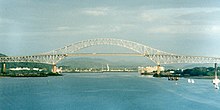Bridge of the Americas
| Bridge of the Americas | |
|---|---|
 |
|
| Carries | Four lanes of Carretera Panama-Arraijan, pedestrians and bicycles |
| Crosses | Pacific approach to the Panama Canal |
| Locale | Balboa, Panama |
| Characteristics | |
| Design |
Steel through arch bridge John F. Beasly & Company |
| Total length | 1,654 m (5,425 ft) |
| Width | 10.4 m (34 ft) |
| Longest span | 344 m (1,128 ft) |
| Clearance below | 61.3 m (201 ft) at high tide |
| History | |
| Opened | October 12, 1962 |
| Statistics | |
| Daily traffic | 35,000 (2004) |
The Bridge of the Americas (Spanish: Puente de las Américas; originally known as the Thatcher Ferry Bridge) is a road bridge in Panama, which spans the Pacific entrance to the Panama Canal. Completed in 1962, at a cost of US$20 million, it was the only non-swinging bridge (there are two other bridges, one at the Miraflores locks and one at the Gatun locks) connecting the north and south American land masses until the opening of the Centennial Bridge in 2004. The bridge was designed by Sverdrup & Parcel.
The Bridge of the Americas crosses the Pacific approach to the Panama Canal at Balboa, near Panama City. It was built between 1959 and 1962 by the United States at a cost of 20 million U.S. dollars. From its completion in 1962 until the opening of the parallel Centennial Bridge in 2004, the Bridge of the Americas was a key part of the Pan-American Highway. The Bridge of the Americas greatly increased road traffic capacity across the canal. There are two earlier bridges which cross the canal, but they use moveable designs and have limited traffic capacity. These earlier spans include a small swinging road bridge (built into the lock structure at Gatún) and a swinging road/rail bridge (constructed in 1942 at Miraflores). The Centennial Bridge was constructed to eliminate the bottleneck of and reduce traffic congestion on the Bridge of the Americas.
The bridge is a cantilever design where the suspended span is a tied arch. The bridge has a total length of 1,654 m (5,425 ft) in 14 spans, abutment to abutment. The main span measures 344 m (1,129 ft) and the tied arch (the center part of the main span) is 259 m (850 ft). The highest point of the bridge is 117 m (384 ft) above mean sea level; the clearance under the main span is 61.3 m (201 ft) at high tide. Ships must cross under this bridge when traversing the Panama Canal, and are subject to this height restriction. The world's largest cruise ships, Oasis of the Seas, Allure of the Seas and the Harmony of the Seas will fit within the canal's widened locks, but they are too tall to pass under the Bridge of the Americas even at low tide unless the Bridge of the Americas is raised in the future. (The Centennial Bridge is also a fixed obstacle, but its clearance is much higher: 80.0 m (262 ft).)
...
Wikipedia
